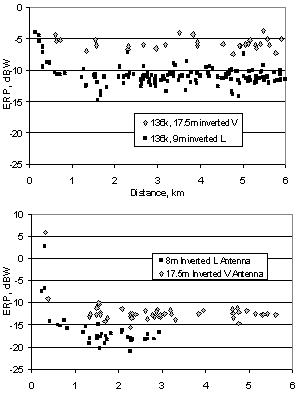At 14:54 08/07/2003 +0200, you wrote:
I think 2km is not quite enough at 73kHz. I calculated the total field
over perfect ground at 2km distance by means of a antenna simulation
program. I found E/H = 342 ohm. In the far field E/H ought to be 377
ohm (= 120.pi ohm). So apparently at 2km the near field is not yet small
enough to be negligible.
I found that even at 137kHz measurements were inconsistent at 2km so I
changed to over 4km.
Dear Dick, LF Group,
When I was doing my field-strength measurement experiments, one result was
to plot ERP calculated from field strength against measuring distance, with
the idea of finding how far away it was necessary to be to get far-field
conditions. The plots are shown in the attached file - the upper one is for
136k, the lower one for 72k. You can see from the plots that effective ERP
increases at short distances , but once you reach distances > 1km, ERP
becomes more or less independent of distance. There is also a "scatter" in
values of ERP of about +/-3dB; this looks like random errors or noise in
the measurement, but is not - returning to the same measurement site gives
exactly the same "error" each time, so these variations are a property of
the measuring site
DF6NM made some interesting plots of the data at short distances, which
showed that these values conform fairly well to what you would expect
theoretically from a short monopole in the near field. In practice, there
seems to be more possibilities for error with measurements at short
distances; for example, I found at some positions within 2km of my QTH
where the ERP was several dB higher than anywhere else - they turned out to
be close to the overhead phone line to my house, which runs quite near the
antenna and appears to act as a rather inefficient transmission line, with
a detectable standing wave pattern at 136k. Also at short distances, there
are usually fewer suitable measuring sites available. At greater distances,
there are fewer problems like this, but things like overhead power lines,
steel road bridges and large buildings may have a significant effect on the
measured field strength. I eliminated from the graphs all points where I
could find an obvious reason for suspicion, but as you can see, there is
still significant variation between different measuring sites. This means
it is necessary to make several measurements at different sites in order to
get an accurate idea of the ERP. Dick's calculation indicates that the H
field is increased by about 1dB relative to the E field at 2km on 73kHz -
but if this effect is present in my data, it is swamped by other sources of
variation.
Cheers, Jim Moritz
73 de M0BMU 
|

